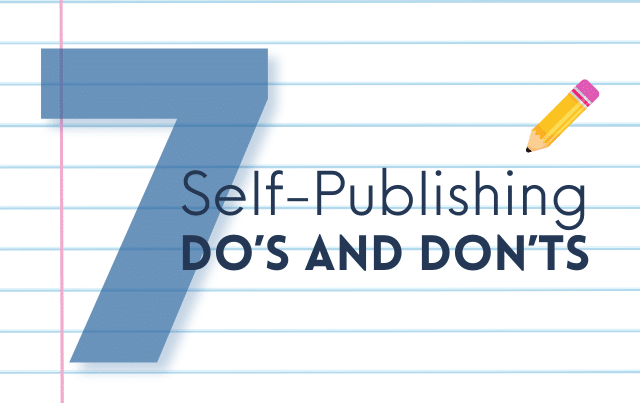Seven Self-Publishing Do’s and Don’ts
Self-publishing offers writers opportunities that other publishing routes are not able to. It’s only this path where authors have creative control. Consider production and marketing: You always have the final say at every step of the process. But just like all other paths, there are common mistakes authors make that might hinder you from achieving your literary goal. Follow these seven tips so that you can make an effortless publishing debut.
1- DON’T design your own cover. Unfortunately, the cover does matter, and nothing can repel readers like an ugly book design. Regardless of how well your book is written, a reader has to get through that cover to reach the actual text, and that’s unlikely if it isn’t eye-catching and interesting.
DO have a cover designed by a professional—or at least someone with a background in cover design. Book covers are an art form all their own, and it’s the rare author who’s proficient at both writing and cover design.
2- DON’T use “novelty” typefaces for your book. “Comic Sans” and “Chiller” have their place—and that place is in emails to friends and invitations to Halloween parties. What seemed fun and whimsical on your Word document looks downright childish in a bookstore.
DO use traditional typefaces. Garamond, Bembo, Janson, Electra, or Caslon will give your book a classy and professional look.
3- DON’T reuse an ISBN. Your first book didn’t sell that many copies, and now you’re self-publishing your second. Why not just move that old ISBN (International Standard Book Number) over to the new book and save a few bucks? No, no, no.
DO use a different ISBN for each book. Not only does an ISBN identify a unique book, it also identifies the book’s edition and format. For example, your book’s hardcover, paperback, and (depending on who you ask) e-book versions each require their own ISBN, as do their different editions.
4- DON’T handle editing yourself. Of course, you should re-read your book, make changes, look for mistakes, and fact-check. You probably won’t catch everything, though; plus, you already know what you meant when you wrote the draft, so your mind is prone to “fill in the blanks” without realizing it.
DO have someone else, preferably someone with an editing background, review your book. If possible, enlist the services of a professional editor to review your work—not just for spelling, punctuation, or grammar mistakes, but also for character development and story content. An educated second opinion can raise the quality of your work more than you might expect.
5- DON’T assume that an image will look good on the page because it looked good on your computer display. On your computer screen, images are displayed at 72 dots per inch (dpi) in what’s called the Red-Green-Blue (RGB) color space.
DO make sure your image is prepared with the proper resolution and color space. Pictures in printed books are usually 300 dpi and use the Cyan-Magenta-Yellow-Black (CMYK) color space. Make sure your graphics are prepared for the format in which they’ll be displayed.
6- DON’T be stingy with your book. Go out and tell the world that it exists – Even more so, share the contents. If you don’t promote your book, no one will know to support you.
DO offer free content. If you are a first-time author, potential readers need to know a good part of your book before they decide it’s worth paying for. Share an excerpt of your book (even an entire chapter) or a PDF workbook connected to the book to those that give their email info on your author website. Including Free Bonuses where you can be a very beneficial marketing strategy.
7- DON’T try to do it alone. There are people who have gone before you and made the beaten path! Don’t try to reinvent the wheel. Believe us, we know. Go with the Experts.
DO partner with an agency who is truly committed to helping you succeed. Some companies will try to rip you off and scam you into selling your royalties to them. Find an ethical self-publishing company that allows you to keep all of your royalties and earnings.




0 Comments